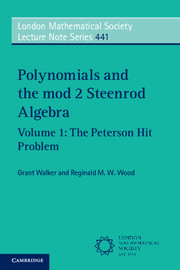Book contents
- Frontmatter
- Contents of Volume 1
- Contents of Volume 2
- Preface
- 1 Steenrod squares and the hit problem
- 2 Conjugate Steenrod squares
- 3 The Steenrod algebra A2
- 4 Products and conjugation in A2
- 5 Combinatorial structures
- 6 The cohit module Q(n)
- 7 Bounds for dim Qd(n)
- 8 Special blocks and a basis for Q(3)
- 9 The dual of the hit problem
- 10 K(3) and Q(3) as F2GL(3)-modules
- 11 The dual of the Steenrod algebra
- 12 Further structure of A2
- 13 Stripping and nilpotence in A2
- 14 The 2-dominance theorem
- 15 Invariants and the hit problem
- Bibliography
- Index of Notation for Volume 1
- Index for Volume 1
- Index of Notation for Volume 2
- Index for Volume 2
1 - Steenrod squares and the hit problem
Published online by Cambridge University Press: 06 November 2017
- Frontmatter
- Contents of Volume 1
- Contents of Volume 2
- Preface
- 1 Steenrod squares and the hit problem
- 2 Conjugate Steenrod squares
- 3 The Steenrod algebra A2
- 4 Products and conjugation in A2
- 5 Combinatorial structures
- 6 The cohit module Q(n)
- 7 Bounds for dim Qd(n)
- 8 Special blocks and a basis for Q(3)
- 9 The dual of the hit problem
- 10 K(3) and Q(3) as F2GL(3)-modules
- 11 The dual of the Steenrod algebra
- 12 Further structure of A2
- 13 Stripping and nilpotence in A2
- 14 The 2-dominance theorem
- 15 Invariants and the hit problem
- Bibliography
- Index of Notation for Volume 1
- Index for Volume 1
- Index of Notation for Volume 2
- Index for Volume 2
Summary
Introduction
In this chapter we introduce our main subject, the algebra of polynomials in n variables over the field of two elements F2 under the left action of linear operations called Steenrod squares and the right action of n × n matrices. We denote this polynomial algebra by P(n) = F2[x1, …, xn], in variables xi for 1 ≤ i ≤ n. For small n it is convenient to use x, y, z for variables. The algebra P(n) is graded by the vector spaces Pd(n) of homogeneous polynomials of degree d ≥ 0. In particular, the variables xi have degree 1, and form a basis of the n-dimensional vector space P1(n).
In Section 1.1 the Steenrod squaring operations Sqk : Pd(n)→Pd+k(n) are defined for k ≥ 0, and their basic properties, such as the Cartan formula, are established. In Section 1.2 we explain how Pd(n) is a right module over the monoid algebra F2M(n), where M(n) = M(n,F2) is the multiplicative monoid of n × n matrices over F2. This right action commutes with the left action of the Steenrod squares. By restricting to non-singular matrices, Pd(n) gives a modular representation of the general linear group GL(n) ⊂M(n), and the Steenrod squares are maps of F2GL(n)-modules. Further properties of the Steenrod squares are developed in Section 1.3.
In Section 1.4 we introduce the hit problem. We call a polynomial ‘hit’ if it is a linear combination of elements in the images of positive Steenrod squares. The hit polynomials form a F2M(n)-submodule H(n) of P(n). The corresponding quotient Q(n) = P(n)/H(n) is the cohit module, and the hit problem is to determine Qd(n) for each n and degree d. Although this problem arose in algebraic topology, we treat it simply as a problem in algebra. We shall see later that the cohit modules are also of interest in group representation theory.
In the 1-variable case, the hit problem is a straightforward exercise in handling binomial coefficients mod 2. We give the solution in Section 1.4. For all n, certain monomials called spikes cannot appear in the image of a positive Steenrod square.We introduce these in Section 1.5. In the rest of the chapter we focus on the 2-variable case.
- Type
- Chapter
- Information
- Polynomials and the mod 2 Steenrod Algebra , pp. 1 - 18Publisher: Cambridge University PressPrint publication year: 2017

